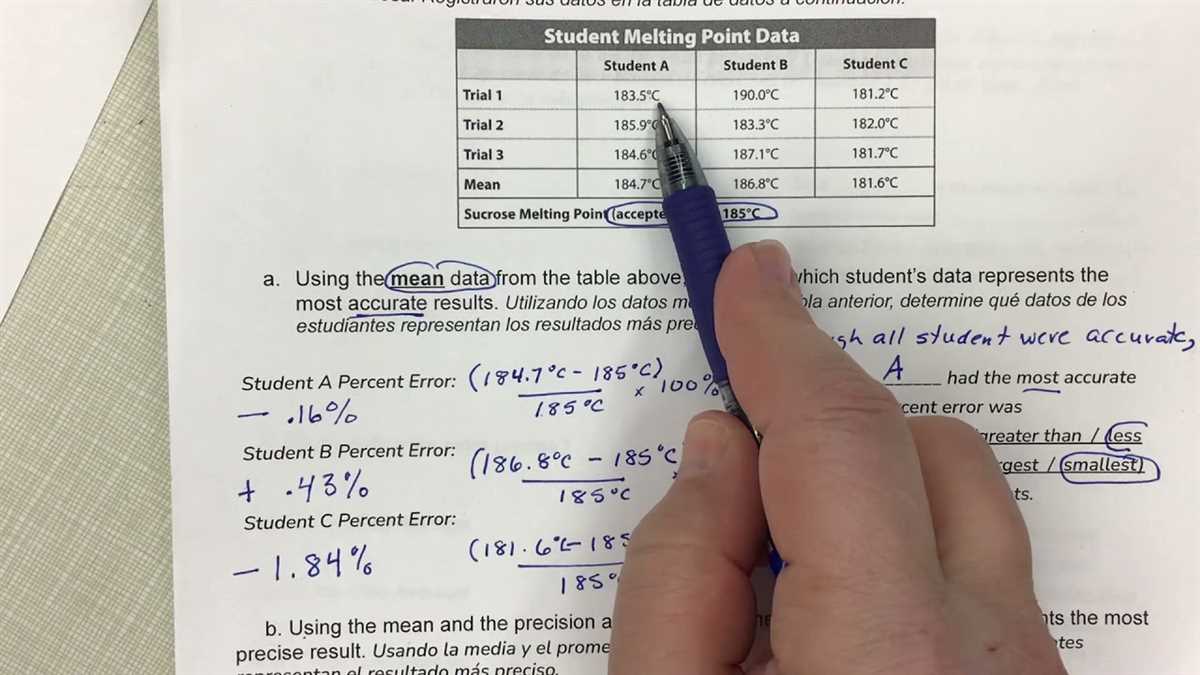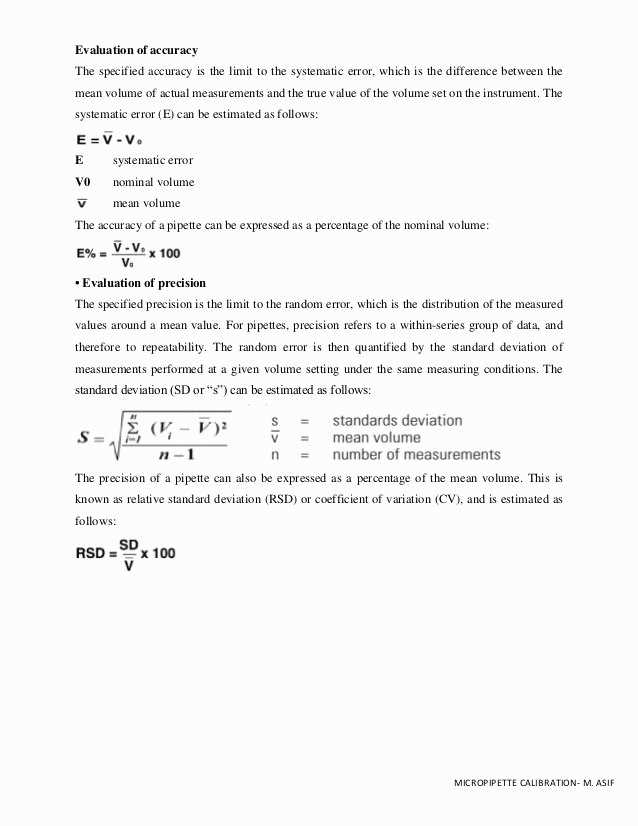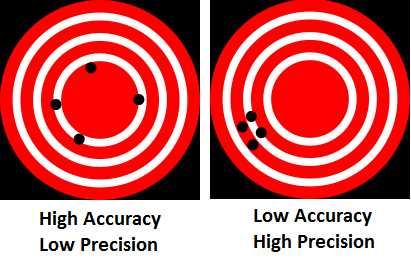
Accuracy and precision are two important concepts in the field of measurement. While they are often used interchangeably, they actually have different meanings and implications. In this worksheet, we will explore the differences between accuracy and precision and how to calculate them.
Accuracy refers to how close a measurement is to the true or accepted value. It represents the correctness or trueness of a measurement. On the other hand, precision refers to how close a set of measurements are to each other. It represents the consistency or reliability of a measurement. In other words, accuracy focuses on the target, while precision focuses on the consistency of hitting the target.
To calculate accuracy, you need to compare the measurement with the true or accepted value. The difference between the two is called the absolute error. Absolute error can be positive or negative depending on whether the measurement is higher or lower than the true value. To calculate the accuracy, you can use the formula: Accuracy = (|Measured Value – True Value| / True Value) × 100%. The result is usually expressed as a percentage.
Precision, on the other hand, can be calculated using a variety of statistical measures such as range, variance, and standard deviation. Range is the difference between the largest and smallest measurements in a set. Variance measures the spread or dispersion of the measurements. Standard deviation is a measure of the average distance between each measurement and the mean of the set. The smaller the standard deviation, the more precise the measurements are.
Understanding Accuracy and Precision
Accuracy and precision are two important concepts in the field of measurement. They are often used interchangeably, but they have distinct meanings and applications. Understanding the difference between accuracy and precision is essential for conducting reliable experiments and obtaining valid results.
Accuracy refers to how close a measured value is to the true or accepted value. It is a measure of how well a measurement represents the actual quantity being measured. In other words, accuracy is a measure of correctness. For example, if a target is hit at the center every time, the measurements are accurate. Accuracy is influenced by systematic errors, such as instrument calibration or environmental conditions, and can be improved by minimizing these errors.
Precision, on the other hand, refers to how close multiple measurements of the same quantity are to each other. It is a measure of consistency or reproducibility. Precision is not affected by whether the measured values are close to the true value, but rather focuses on the consistency of the measurements. For example, if a target is consistently hit in the same spot, even though it may not be the center, the measurements are precise. Precision is influenced by random errors, such as measurement fluctuations or human error, and can be improved by increasing the number of measurements taken.
Both accuracy and precision are important in scientific research and experimentation. A measurement can be accurate but not precise, if it consistently produces the same value that is far from the true value. Conversely, a measurement can be precise but not accurate, if it consistently produces values close to each other but far from the true value. Ideally, scientists strive for both accuracy and precision in their measurements to obtain reliable and meaningful results.
Understanding the difference between accuracy and precision allows scientists to evaluate and compare the quality of measurements, identify sources of error, and improve the overall reliability of their experiments. It is important to consider both accuracy and precision when interpreting and reporting scientific data, as they provide different insights into the validity of the measured values.
The Importance of Accuracy and Precision in Scientific Measurements

In the field of science, accurate and precise measurements are of utmost importance. These measurements provide the foundation for scientific research and help ensure the reliability and validity of experimental results. Both accuracy and precision play critical roles in obtaining meaningful data and drawing accurate conclusions.
Accuracy refers to how close a measured value is to the true value of the quantity being measured. It is essential to minimize any systematic errors that may lead to inaccurate measurements. By consistently refining measurement techniques and using calibrated instruments, scientists strive to achieve the highest level of accuracy possible. Accurate measurements are crucial for establishing the fundamental relationships between variables and for making reliable predictions in scientific models.
Precision, on the other hand, refers to the level of consistency and reproducibility in multiple measurements of the same quantity. Precise measurements have very little scatter or variation among the recorded values. This is achieved by reducing random errors that may arise from limitations in experimental techniques or instruments. Precise measurements help scientists assess the reliability and uncertainty associated with their data and provide a basis for statistical analysis.
In the field, both accuracy and precision are equally important. While accuracy ensures the correctness of measurements in relation to the actual value, precision guarantees the consistency and reproducibility of results. By combining accurate and precise measurements, scientists are able to establish solid foundations for scientific theories, confidently make predictions, and advance our understanding of the natural world.
Difference between accuracy and precision

Accuracy and precision are two important concepts in the field of measurement and data analysis. While they are closely related, they have distinct meanings and implications.
Accuracy refers to how close a measured value is to the true value. It is a measure of how well an experiment or measurement reflects the actual value being measured. In other words, accuracy indicates the absence of systematic error in a measurement. For example, if a scale consistently reads 1 kg higher than the actual weight, it is not accurate.
Precision refers to the reproducibility or repeatability of a measurement. It is a measure of how close a set of measured values are to each other. Precision indicates the absence of random error in a measurement. A measurement can be precise even if it is not accurate. For example, if a scale consistently reads 10.1 kg, 10.2 kg, and 10.3 kg for three different weights that are actually 9 kg, the measurements are precise but not accurate.
Accuracy and precision can be visualized using the analogy of shooting at a target. Accuracy refers to how close the shots are to the bullseye, which represents the true value. Precision refers to how close the shots are to each other, indicating consistency in the measurements.
In summary, accuracy and precision are both important in measurements, but they represent different aspects. Accuracy relates to the true value, while precision relates to the consistency of measurements. It is possible to have measurements that are accurate but not precise, precise but not accurate, or both accurate and precise.
Factors affecting accuracy and precision

Accuracy and precision are two important concepts in the field of measurement. Accuracy refers to the closeness of a measured value to the true value, while precision refers to the consistency or reproducibility of a series of measurements. Several factors can affect the accuracy and precision of measurements.
Instrument calibration: One of the most significant factors affecting accuracy and precision is the calibration of the measuring instrument. Calibration ensures that the instrument is properly adjusted to provide accurate and precise measurements. Regular calibration checks are necessary to maintain the accuracy and precision of the instrument.
Environmental conditions: The environmental conditions in which the measurement is taken can also impact accuracy and precision. Factors such as temperature, humidity, and air pressure can affect the performance of the measuring instrument and, consequently, the accuracy and precision of the measurements. It is important to control and monitor these environmental conditions to minimize their impact.
Human error: Human error is another factor that can affect the accuracy and precision of measurements. Mistakes in reading the instrument, improper technique, or lack of concentration can introduce errors into the measurement process. Training, attention to detail, and proper technique can help reduce human error and improve accuracy and precision.
- Sample characteristics: The characteristics of the sample being measured can also influence accuracy and precision. For example, heterogeneous samples or samples that are not representative of the entire population may result in inaccurate or imprecise measurements. It is important to carefully consider the sample characteristics and ensure that they are representative of the population being studied.
- Data processing: The way data is processed and analyzed can also impact accuracy and precision. Errors in data entry, calculation mistakes, or inappropriate statistical methods can lead to inaccurate or imprecise results. It is essential to use appropriate data processing techniques and verify the accuracy of the data before drawing conclusions.
In conclusion, several factors can affect the accuracy and precision of measurements. Instrument calibration, environmental conditions, human error, sample characteristics, and data processing all play a role in determining the accuracy and precision of measurements. By understanding and controlling these factors, scientists and researchers can ensure that their measurements are accurate and precise, leading to reliable and meaningful results.
Methods to Improve Accuracy and Precision
In order to ensure accurate and precise measurements, several methods can be employed:
1. Calibration:
Calibration involves comparing measurements taken with a device to known values in order to determine any systematic errors or discrepancies. By calibrating instruments regularly, accuracy can be improved by correcting for any biases or inaccuracies.
2. Repeated Measurements:
Taking multiple measurements and calculating the average can help to minimize random errors and increase precision. The more measurements that are taken, the more reliable the average value becomes.
3. Standardization:
Using standardized procedures and protocols can help to eliminate variations in measurement techniques and improve consistency. This is particularly important when multiple individuals are involved in data collection.
4. Quality Control:
Implementing quality control measures, such as regular maintenance and inspection of equipment, can help to identify and address any issues that may affect measurement accuracy and precision.
5. Training and Expertise:
Providing proper training to individuals involved in data collection can help to minimize errors caused by human factors. Familiarity with the equipment and techniques, as well as an understanding of potential sources of error, can greatly improve accuracy and precision.
In conclusion, accuracy and precision are crucial in scientific measurements. By using methods such as calibration, repeated measurements, standardization, quality control, and training, scientists can ensure that their data is reliable and accurate. It is important to consistently strive for both accuracy and precision in order to obtain the most trustworthy results.
Q&A:
What is accuracy?
Accuracy is a measure of how close a measured value is to the true value or the target value.
What is precision?
Precision is a measure of how close the measured values are to each other. It is an indicator of the repeatability or consistency of the measurement.
How can accuracy be improved?
Accuracy can be improved by calibrating the measuring instruments regularly, using high-quality instruments, minimizing systematic errors, and using appropriate statistical techniques to correct for bias. Additionally, conducting multiple measurements and averaging the results can also help improve accuracy.
How can precision be improved?
Precision can be improved by taking multiple measurements and calculating the average, reducing random errors by using precise instruments and techniques, increasing the sample size, and conducting replicate experiments. It is also important to control external factors that can affect the measurement, such as temperature, humidity, and operator skill.